Before you collect -
Knowing your wild plants - the kind of soil, degree of shade, amount of moisture, temperature, acidity, and the other conditions that will made it grow best.
Where to collect -
It's fun to collect the wildflowers for your garden or diversify the woodland species in your landscape, because no matter how long you've been at it, there are always interesting additions to for your collection.
The essential thing is to gather plants in such a way that you neither infringe on the rights of others nor lessen the supply of many of the species already too scarce.
Pretty Blue Cosmos Flowers, eh?
Familiarize yourself with state laws prohibiting the removal of rare wildflowers, ferns, and bushes. Common kinds of plants - those especially abundant in any given locality - can usually be collected in reasonable quantities with little harm (Birdseye, 1951 p. 22-23).
When to Collect -
Wildflowers may, with sufficient care, be transplanted at any time of year, even when the ground is frozen. Generally speaking, however, it is best to transplant plants during their dormant seasons. That is, after plants have passed their periods of active growth.
Coniferous trees can be best moved immediately after their new foliage has matured - the end of August to September. This allows enough time for the formation of new rootlets before freezing weather sets in.
Most deciduous trees should be transplanted during the later part of September or early October, when their leaves are beginning to change color. However, in very cold areas they may be handled in the very early spring before their buds have begun to swell. Bushes are best moved after the leaf fall, when they are fully dormant (Birdseye, 1951 p. 24-25).
These deciduous tree seedlings (Yellow Popular pictured left in the
purple metal bucket, Red Maple pictured right in the
large light blue metal bucket and below in the
small green metal bucket) I collected two days ago this spring. As long as these receive sufficient water, sunlight and other species-specific requirements they'll live long into their fall dormant period when they will be transplanted.
Yellow-Popular or Tulip Tree (Liriodendron tulipifera L.)
This is a commonly occurring tree throughout Virginia, reaching its largest size along deep moist soils along streams and in the lower mountain coves. Height of 60 to 100 feet with diameters of 3 to 4 feet. The tree has been excessively cut, but is reproducing rapidly and is one of the most abundant and valuable trees in second-growth forests. It can be planted as an ornamental or a shade tree. The greenish yellow tulip shaped flowers occur in early April (Virginia Department of Forestry p.60). I think the leaf looks like the face of a cat.
Red Maple (Acer rubrum L.)
It is used as a shade tree (although the sugar maple is better for this purpose) and occurs commonly across the state. The tree produces soft maple wood used for furniture, woodenware, and also for fuel (Virginia Department of Forestry p.60).
Collecting Equipment
Sure, many kinds of wildflowers can be collected without any more equipment than a stout stick and your hands, but a certain amount of paraphernalia will save you a lot of time and sore fingers.
- Most important of all, you will need a long, strong (so brute force can be used in prying plants from rocks), sharp (to cut through hard ground and small roots) trowel like this one.
- A keen bladed pocket knife will come in handy, particularly for cutting the stakes with which you should protect the long blossom stalks of certain plants and the large fronds of some kinds of ferns. Case knifes like these are durable steal made in the USA.
- In addition to these tools you'll want one or more baskets with stout handles, in which to carry your plants out of the woods.
- Have a half gallon of water to moisten roots dug from dry ground.
- A plentiful supply of bags and wrapping material are also very important. You ability to successfully carry out your collecting operations depends on these. Bags should be waterproof and various sizes. For wrapping earth balls too big for bags, you will want some large burlap sacks or strong old cloth and safety pins.
How to Collect
- clear away ground litter that might obstruct your process.
- make a circular cut 12 to 18 inches in diameter and about 8 inches deep around the plant - these diameter measurements of the cut depending on the size of your plant and the depth depending on the soil conditions. There will probably be several extraneous small roots and stems to be severed by your trowel.
- Pry out the root ball and place it carefully in one of your moisture-tight bags.
Remember that no two patches of soil are exactly alike, and that your new plant will be most at home in it's new location if it is surrounded there by some of the earth from which you took it.
I collected plants to give as gifts in these colorful buckets to be transplanted in the fall. Each bucket came with a plastic liner and holes should be punched in the bucket and liner bottom with a hammer and nail. Placing a few rocks in the bottom of the plastic liner helps with plant drainage - you don't want to drown your plants with too much water.
Bibliography
Birdseye, C., & Birdseye, E. (1951). Collecting Wildflowers. Growing woodland plants. New York: Dover Publications.
Forest trees of Virginia. (1992). Charlottesville, Va. (Box 378, Charlottesville 22903): Dept. of Forestry.




























